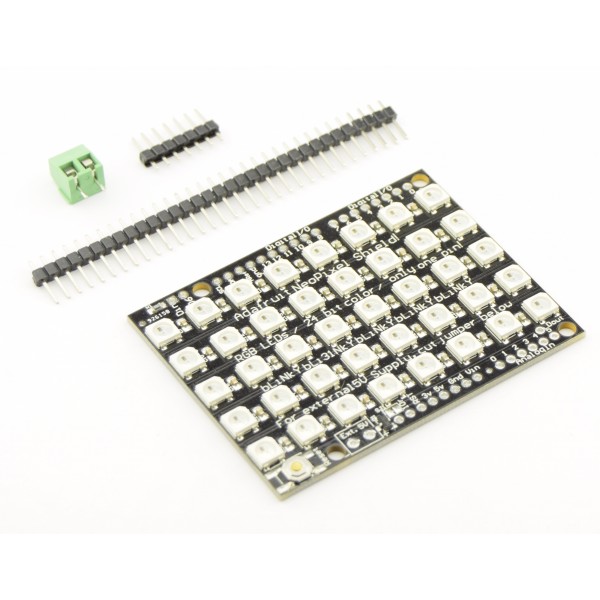WS2812B Digital 5050 RGB LED - Shield 40 LEDs - 8x5 Matrix
- Availability: Directly available from warehouse in Eindhoven
- SKU: 000667
€11.50
Ex Tax: €9.50
Please note! Due to the busy period around Black Friday and the holidays, there is a chance of longer delivery time.
Your shopping cart is empty!

This is a clone version of the adafruit Neopixel shield. There are 40 WS2812B LEDs in matrix form of 8 x 5 LEDs. These can all be individually controlled via pin 6.
The shield is suitable for all Arduino's that can control these digital WS2812B LEDs via pin 6. and compatible with the standard Arduino shield format and pin layout.
With this (unsoldered) shield a series of male pin headers are included that can be soldered onto the shield. A small green terminal block is also supplied for possible external power supply of the LEDs.
This can be soldered at the location indicated with "Ext.5V". If the external power supply is used, the connection must also be disconnected to the right of this connection (along the small black component that has 3 feet)
The external power supply for the LEDs must be between 4 and 6V DC (5V recommended)
This shield has a Din and Dout like all other WS2812B LEDs. You can find these in the corners of the shield. These can be used to link multiple shields or other WS2812B products to this shield.
Note: This shield can use quite a bit of current when all LEDs are fully on. (white at full brightness) The Arduino you use may not be strong enough and external power is required. This problem can be solved by making the LEDs less bright in the software.
For more information on the control and operation of the WS2812B LED you can read the product description of one of our other products:
WS2812B Digital 5050 RGB LED Strip - 60 LEDs 1m
This product has 0 review(s) in total.
Use a stable, CE-approved power supply with the correct voltage that can supply sufficient current. The maximum current that an LED can draw is indicated on the product page. Multiply this number by the number of LEDs to calculate the total maximum current. This maximum current is the minimum current that the power supply must be able to supply.
To connect a digital LED strip, we offer two options below. The first is recommended as it requires fewer components and fewer connections.
Requirements:
The following components are required to operate a product with digital LEDs:
Connecting the strip:
*There are many power supplies on the market that carry a China export ("fake" CE marking) or carry a CE marking but are not actually CE certified. We advise against using these, often cheap (Chinese), power supplies because they often do not provide a stable voltage. A stable voltage is essential to prevent damage to the LED strips and to ensure stable operation.
Requirements:
The following components are required to operate a product with digital LEDs:
The following parts are optional:
Connecting the strip:
*There are many power supplies on the market that have a China Export ("fake" CE marking) or carry a CE marking, but are in reality not CE approved. We do not recommend using these, often cheap (Chinese), power supplies because they generally do not provide a stable voltage. A stable voltage is essential to make the LEDS work stable, and to prevent damaging them.
More information:
We recommend reading the following pages for more information (especially when using multiple LED strips): Powering Neopixels and Adafruit NeoPixel Überguide.
This can have several causes. The most common causes are:
Signal voltage too low
For example, WS2812B LEDs have a signal voltage of 5V. When these are controlled with a voltage of 3.3V (as with ESP32/ESP8266/Raspberry Pi), data may not be properly received at one or more LEDs, resulting in the wrong color. This can be solved by increasing the signal voltage to 5V using a level converter.
Noise on the signal pin
The signal pin is sensitive to noise. This can be solved by connecting a 470Ω resistor in series between the microcontroller and the signal pin of the LEDs.
Voltage drop in supply voltage
Particularly with many LEDs in succession, it can happen that a part does not display the right color. This may be a sign that the supply voltage has dropped too far due to losses in the cabling. This can be solved by using extra thick power cables and connecting them between each strip.